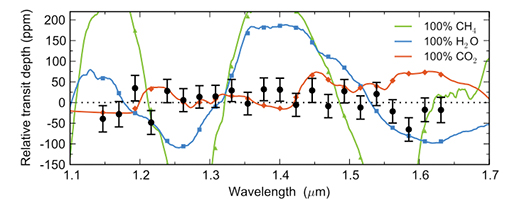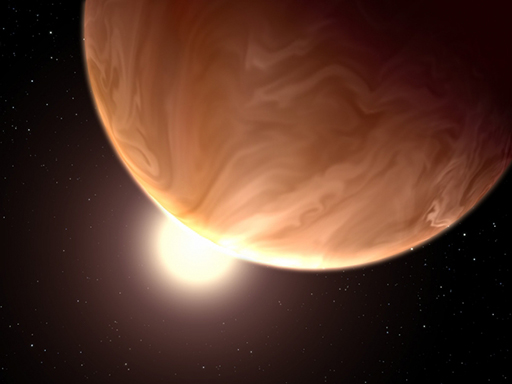4.2 The small ones: GJ 1214 b and GJ 1132 b
Although it’s generally easier to find and measure large planets, there are a few smaller planets that have been looked at in detail. One of these is the super-Earth GJ 1214 b.
As you learned in Week 6, GJ 1214 b was discovered in 2009 by the MEarth survey. Its discovery generated a lot of excitement, because at the time it was one of the smallest exoplanets found. It is only about 2.5 times the radius of the Earth, so it is somewhere between Earth and Neptune in size. It is also much cooler than most of the hot Jupiters found, at only around 200 °C – although it’s still a bit on the toasty side compared to Earth!
Because it orbits a relatively nearby, small, cool star, GJ 1214 b was a perfect target for transmission spectroscopy. Remember, nearby stars, and stars that are small, make it much easier to detect a planet and then make precise measurements. Virtually every available instrument was used to observe GJ 1214 b, and, at first, results seemed to be promising but inconclusive. There were hints of wiggles in the spectrum, but no gas was firmly identified.
The shock came when a team of astronomers from Chicago watched GJ 1214 b transit on 12 separate occasions, and combined the results. Suddenly, what they were looking at was a completely flat, featureless spectrum (Figure 20). That wasn’t the plan at all!

If GJ 1214 b has an atmosphere, its transmission spectrum is expected to be wiggly, like those of the hot Jupiters you looked at. So why is it so flat? Maybe GJ 1214 b doesn’t have an atmosphere at all? If it is just a bare lump of rock then its spectrum would look that flat.
Activity _unit8.4.2 Activity 3 Does GJ 1214 b have an atmosphere?
In Week 2, you learned about planet density. For GJ 1214 b to be rocky, it must have a suitable density for a rocky planet. But does it? You decide.
The density of GJ 1214 b is 1.6 g/cm3. Can you remember the typical densities of planet types you met earlier in the course? Which type of Solar System planet is GJ 1214 b more likely to resemble?
Answer
The density of GJ 1214 b is much lower than the density of Earth (5.5 g/cm3). In fact, it has the same density as the ice giant Neptune, and so it is probably not a rocky planet.
You probably decided that GJ 1214 b isn’t dense enough to be rocky. So that’s not a good explanation for why its spectrum is so flat. What other reason could there be?
It turns out that the clouds struck again – GJ 1214 b is just a very cloudy planet. If a planet is cloudy enough and the clouds are high up, it can stop almost all starlight from getting through the atmosphere. That means that there are probably gases there, we just can’t see the wiggles.
The MEarth survey found another small planet in 2015, called GJ 1132 b. Unlike GJ 1214 b, this planet is closer to being Earth-sized – it’s radius is 1.2 RE – and its density indicates that it is probably rocky. GJ 1214 b may not have turned out to be the super-Earth everyone wanted, but GJ 1132 b looks more likely to fulfil expectations. Like GJ 1214 b, it is close by so is an exciting prospect for detailed study. Its temperature is likely to be similar to that of Venus – so over the next years we might have the opportunity to study a Venus twin in detail. Of course, Venus is very cloudy, so transmission spectroscopy of GJ 1132 b may also give us a flat line. Initial spectroscopic studies are giving differing results and we will probably have to wait for new technology that you’ll learn about in Week 8 to really know what GJ 1132 b is like.
Incidentally, the record to date for the smallest exoplanet goes to Kepler-37 b, with a radius of 0.34 RE, smaller than Mercury and only just a little larger than our Moon. This ‘sub-Earth’ is thought too small and too hot to hold onto any atmosphere though.

